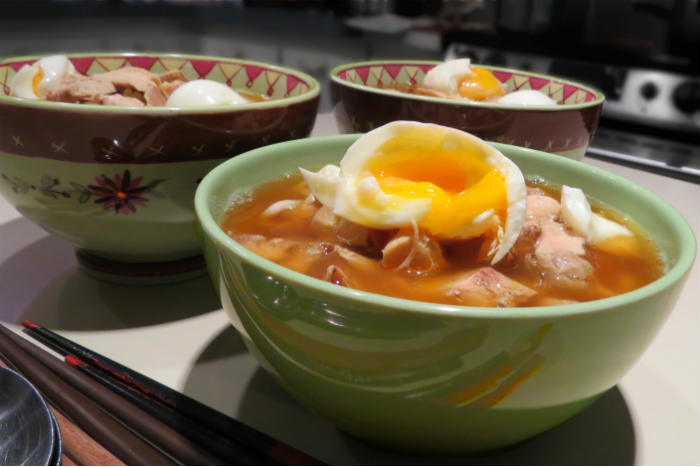
Moon viewing noodles are customarily eaten in Japan during Tsukimi, the festival honoring the first full moon of Autumn. This first month of 2014 had a special full moon: a “mini-moon,” which is the smallest full moon we will see this year. Astronomically, it is a full moon which is the furthest distance from Earth (apogee). The Moon was 16% smaller and 30 times dimmer than the super-moon which will occur in August.In honor of this occasion, we ate udon in hot broth topped with an egg. Tsukimi (moon-viewing) noodles include a whole raw egg in the center of the dish like a full moon surrounded by “clouds” of noodles. There are so many cautions against eating raw eggs in the U.S. (and I wanted to make this a complete meal) that we had soft boiled eggs, and chicken, with our noodles, thus making the dish “mother and child” noodles: oyako udon.
Oyako Udon
Mother and Child Udon
from: Hiroko’s American Kitchen
Cooking with Japanese Flavors
6 Easy Sauces; 125 Modern Recipes
Have prepared: 10 teaspoons (a bit less than ¼-cup) of Super Sauce (click to view and print the recipe).
- small bunch of spinach (10 oz.)
- 14 oz. udon noodles
- 3 skinless chicken thighs (1½ pounds—with bones)
- sea salt and black pepper
- 4 green onions
- 2 teaspoons corn oil
- 1¼ cups Hot Noodle Broth
(note: I like my udon in a bit more broth, say 2½ cups)
(note: I used the chicken stock from cooking the chicken instead of plain water) - 4 poached or soft-boiled eggs
- lemon zest from ½ lemon
- other condiments of your choice
Salt the chicken thighs while you prepare the spinach and noodles. Dry with kitchen towels.
Blanch the spinach in salted water and cool. Squeeze it to remove excess water, then roll it into a cylinder about 1-inch in diameter. Slice into four 2-inch long portions.
Cook the noodles in boiling water, about 1 minute less than the package cooking time. Drain and rinse under cold running water to remove excess starch. Set aside.
Cut the onions into ½-inch diagonal slices, separating the white from the green. Sauté the white parts in medium-sized pot, in the vegetable oil.
Place the chicken thighs into the pot with the onions and add water. Bring to a gentle simmer, then cover, and cook for 1 or 2 minutes. Turn off the heat and let them steep for 15 minutes. Remove to a plate. When the chicken has cooled slice it from the bones into 1-inch pieces. Strain the broth and reserve.
Prepare the Hot Noodle Broth from the recipe below. Bring it to a simmer and add the chicken and onion whites. Cover and cook for 4 minutes.
Poach the eggs and set aside.
To serve:
Pour boiling water over the cooked udon to warm them up, drain, and distribute among four bowls. Arrange chicken and spinach over the noodles, and top with the eggs. Pour hot broth into each bowl and garnish with the onion greens and lemon zest.
fuyu no tsuki 冬の月
This month’s full moon is commonly known as the Wolf Moon. Lesser known but equally appropriate names include Old Moon, Moon after the Yule, Ice Moon, Snow Moon, Hunger Moon, Cold Moon, and the Moon of the Terrible (Sioux). The Lakota Sioux called it “The Moon of Frost in the Teepee”. The Kalamath called it “The Moon of Little Finger’s Partner”.
from the Examiner
through snow clouds and window blinds
still silence no dreams





Ah, the egg thing. When you come to eggs and Japanese cooking, well, there’s always the egg thing. Because, under normal situation, yes. Raw eggs can be hazardous.
The answer– if you have a proper source– is NOT Organic, or free range, or any of the most popular “let’s Healthy” responses. Instead, it’s a processed egg– a Pasterurised egg.
You may have to look for them, a bit. The whites may be a touch cloudy looking. But in taste, cooking, and everything else they are just like any other egg– except that they have had a short sharp heat treatment, which kills the nasty nasty salmonella baccilli. Thus, a “raw” egg that is perfectly safe.
They– not surprisingly– cost a little more than regular eggs, but if you’re going for certain effects, well, they are what you want.
Hi Robert,
Thanks for the information. My neighbors had a few chickens for a couple of years and I wouldn’t have hesitated to eat those eggs raw. They allowed them to roam from their yard to ours and kept them very clean. They were very friendly birds. But foxes or hawks got a couple of the hens so the couple gave up keeping them. I think it’s a lot of work, keeping chickens.
Maybe Whole Foods has pasteurized eggs… I’ve never looked for them!